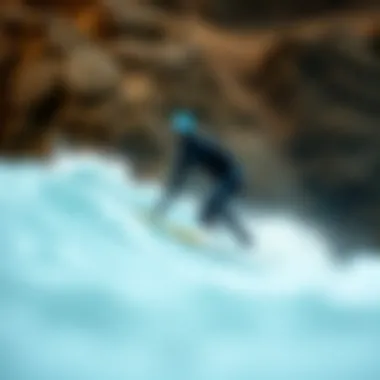Local Guide to Choosing Wetsuits for Sale


Intro
Finding the right wetsuit might feel as daunting as trying to catch the perfect wave. With so many options available, it’s essential to know exactly what you need to begin your search effectively. Whether you’re a surfer, swimmer, or outdoor enthusiast, the perfect wetsuit isn’t just about style; it is about fit, functionality, and local availability.
In this guide, we will explore the different types of wetsuits, the factors you should consider before making a purchase, and how to navigate local retailers to snag the best deals. This is not just a casual stroll down the beach but a deep dive into making an informed decision that suits your specific needs and preferences.
Gear and Equipment
When it comes to water sports, the right gear can make all the difference. The focus on wetsuits is crucial, but around them, other pieces of equipment complement your experience. The world of beach gear offers a treasure trove of options that can either boost your performance or leave you high and dry.
Types of Wetsuits
Like a robust ocean tide, wetsuits come in various styles designed for different water activities and temperature ranges:
- Full Wetsuits: These cover the entire body and are ideal for colder weather. They often come with varying thickness levels to suit different temperature conditions.
- Shorty Wetsuits: As the name suggests, these are shorter and cover only the torso and upper legs. Great for warmer climates, they allow for more freedom of movement.
- Springsuits: A variant of shorties, springsuits offer some long-sleeved options and are perfect for springtime surf when waters start to warm up.
- Dry Suits: Not strictly wetsuits but worth noting, dry suits are designed to keep the user completely dry, using air to insulate against the cold.
Latest Technologies in Wetsuits
Advancements in wetuit technologies have revolutionized the experience for water enthusiasts. Some of the latest innovations include:
- Seamless Construction: This method enhances flexibility and comfort while reducing water penetration.
- Thermal Lining: High-tech thermal materials help maintain body heat, making it more comfortable to stay in colder waters.
- Eco-friendly Materials: A growing trend is the use of sustainable materials in wetsuit manufacturing, appealing to environmentally-conscious consumers.
Essential Accessories for Every Surfer
While finding the right wetsuit is crucial, don’t overlook the necessity of accessories that can significantly enhance your water experience:
- Booties: Adding an extra layer of protection and warmth for your feet, particularly in frigid waters.
- Hoods: Keeping your head warm is essential for extended surfing sessions.
- Gloves: These are useful for hand protection, mainly when surfing in colder climates.
These elements of gear and equipment together form a solid foundation for anyone planning to hit the waves. With a complete understanding of what’s available, you can now focus on narrowing down your ideal wetsuit based on your local options.
Types of Wetsuits
When it comes to surfing or other water activities, choosing the right wetsuit can make all the difference. Picking the correct type is crucial, as it impacts your overall comfort, warmth, and performance in the water. Each style of wetsuit caters to different conditions, water temperatures, and levels of activity. Understanding the nuances between them helps you make an informed decision, ensuring that you won’t find yourself shivering uncontrollably five minutes into your session.
Full Wetsuits
Full wetsuits, as the name suggests, cover the entirety of your body. They are generally made from high-quality neoprene, which provides insulation and flexibility. Ideal for colder waters, these suits typically have varying thicknesses, with options ranging from 2mm to 5mm or more. If you’re planning on surfing in chilly conditions or during the winter months, a full wetsuit is more than just enough; it’s almost a necessity.
The benefits here are manifold. Not only do they keep you warm, but they also offer a layer of protection against UV rays, jellyfish stings, and the occasional scraping on rocks or coral. While they may feel a bit constrictive for some, advanced designs are made to contour comfortably to the body, ensuring you can still move efficiently while paddling or slicing through waves.
Shorty Wetsuits
Shorty wetsuits are a shorter version of their full-body siblings, with sleeves and legs that typically end above the knee and just above the elbow. They offer a balance between warmth and freedom of movement, making them superb for mild, temperate waters. If you live somewhere where the beaches are warm most of the year, shorty wetsuits might be all you need.
One significant advantage of shorty wetsuits is their versatility. They’re not too bulky and can be donned easily. Ideal for summer surf trips or warm weather outings, they provide just enough coverage to protect against sunburn and chill from the water without overheating your body.
Sleeveless Wetsuits
Sleeveless wetsuits, frequently dubbed "vests," are another exciting option for water sports. These suits lack arm coverage but still cover the torso and offer substantial insulation, making them fit for warm weather or aquatic adventures where arm mobility is essential. Whether you’re wakeboarding, paddleboarding, or swimming, a sleeveless wetsuit allows for more flexibility.
Although they’re designed for warmer climates, certain models are still crafted with insulation in mind. This means you can dip your toes into cooler waters without the discomfort of full-blown hypothermia. Just keep in mind that while your arms may be free, your torso will still need adequate coverage to avoid the chill.
Dry Suits vs. Wetsuits
Understanding the distinction between dry suits and wetsuits is vital before making a purchase. While both systems serve to keep you warm in water, their methods and applications differ significantly. A dry suit is designed to keep all water out, allowing you to wear insulating layers underneath. This makes it ideal for extremely cold water or when diving. Dry suits often come with a hefty price tag and tend to be bulkier, but for serious divers or those engaging in prolonged exposure to frigid conditions, they can be a game-changer.
In contrast, wetsuits such as full, shorty, and sleeveless varieties manage a mix of water and insulation. The insulating neoprene traps a thin layer of water against your skin, which gets warm as your body heats it up. While a wetsuit may not be as effective as a dry suit in extreme cold, it offers more mobility and versatility in many recreational scenarios, particularly for surfing or casual snorkeling.
"Choosing the correct wetsuit isn’t merely about style; it’s about comfort, safety, and performance. Understand the environment you’ll be in to select wisely!"
In summary, it’s critical to know the types of wetsuits available and their unique applications. Whether you’re opting for a full wetsuit for those frosty winter sessions or a shorty for summer fun, making the right choice will enhance your water experience, allowing you to focus on just riding the waves.
Benefits of Purchasing Locally
When it comes to selecting the right wetsuit, shopping locally offers a multi-faceted advantage that cannot be underestimated. Instead of scrolling through endless pages of online retailers, or bewildered by the array of options, approaching your search with a local mindset can enrich your buying experience in many meaningful ways. Not only do you support your community when you choose to shop at local stores, but you also enjoy immediate access to fittings, allowing you to discover the right size and style firsthand. Additionally, fostering lasting relationships with your local retailers can lead to personalized recommendations, discounts, and a wealth of insider knowledge that online platforms just can't compete with.


Supporting Local Businesses
Every time you choose to buy from a local shop, you're essentially making an investment in your community. Your dollars are funneled back into the local economy, helping to sustain jobs and keep small businesses afloat. Without fail, local shops are often owned by passionate individuals who really know their products. They're more likely to carry top-shelf wetsuit brands and styles that reflect your surfing culture and preferences.
Moreover, local businesses frequently offer unique, high-quality products that big-box retailers might not have in stock. This can mean lesser-known, but innovative brands or custom fits that online shopping won't provide. It's a win-win—support the community and snag great gear at the same time.
Immediate Access to Fittings
Let's be real; finding the perfect wetsuit is a bit like trying on a pair of jeans. There's no one-size-fits-all option. When shopping at a local store, you can try on different wetsuit styles immediately. Feeling the fit, stretch, and overall comfort is essential to ensure your comfort in water.
Imagine stepping into a store filled with various options while knowing you can try each on for comfort, flexibility, and warmth. This immediate access to fittings gives you the chance to assess how each wetsuit hugs your body and whether or not it restricts your movement—something that simply can't be conveyed through a screen.
Building Relationships with Retailers
Building relationships with local retailers can significantly impact your shopping experience. Regular visits to the same store mean you’ll often find familiar faces ready to assist. The personal connection you develop over time may open up opportunities for tailored advice specific to your needs, which is invaluable when it comes to selecting equipment for your unique surfing style.
Additionally, those relationships can lead to benefits like exclusive first access to new arrivals or sales. As a long-standing customer, a retailer might offer you insights about seasonal changes in wetsuit technology or local surfing conditions that an online review simply cannot provide.
Key Factors When Choosing a Wetsuit
Selecting the right wetsuit is not just a matter of picking a trendy color or pattern; it’s about ensuring comfort, safety, and performance in the water. Every surfer and outdoor enthusiast will tell you, a well-fitting wetsuit makes all the difference. Understanding certain key factors can enhance your experience, especially if you are looking for wetsuits for sale near you. Here, we’ll dive into the aspects that truly matter when deciding on a wetsuit.
Size and Fit
Importance of Accurate Measurement
When it comes to wetsuits, size and fit can’t be stressed enough. Poorly fitting wetsuits lead to discomfort, restrict movement, and ultimately ruin your time in the water. Accurate measurement is not just a box to check; it’s the foundation for a great wetsuit experience. Taking the time to measure your body—chest, waist, hips, and torso—ensures that you get a snug fit. Wetsuits should feel tight but not constricting. A well-fitting wetsuit retains warmth by limiting water circulation, keeping you more comfortable during those long stretches in chilly waters.
Trying on Different Styles
Here’s where the fun begins! Wetsuits come in various styles—shorty, full, sleeveless—and each affects how it feels when you're in the water. Trying on different styles helps you find out what works best for your activities. Perhaps the shorty suits you best for casual summer surfing, while a full wetsuit might be ideal for cold winter waves. Each design has its own appeal and application depending on your water sport. Moreover, don’t shy away from different brands as they may fit you differently. What feels great to someone else may not work for you.
Thickness Ratings
Understanding Water Temperature Requirements
The thickness of a wetsuit directly affects your comfort level in the water, particularly in terms of temperature. Wetsuits are developed in varying thicknesses; the general rule of thumb is thicker suits keep you warmer, while thinner ones allow for greater mobility. If you’re diving in regions with colder temperatures, you'll want to opt for a thicker wetsuit—typically 5mm to 7mm. In contrast, a thinner wetsuit (around 2mm) is perfect for warmer climates. So, understanding your local water temperature can provide a huge advantage.
How Thickness Affects Flexibility
While thickness is essential for warmth, it can also limit your flexibility. A thicker wetsuit may restrict your movements, making it less suitable for activities like surfing where agility is key. Conversely, thinner materials offer more flexibility but provide less thermal protection. It’s all about finding a sweet spot that balances warmth and flexibility, ensuring that your performance is not compromised. Keep in mind—sometimes the best wetsuit for you may not be the thickest one available.
Material Options
Neoprene Quality
The type of material used in a wetsuit significantly impacts its performance. Neoprene is the most common material, but not all neoprene is created equal. Higher-quality neoprene offers better insulation, flexibility, and durability. Investing in a suit with quality neoprene means you’re less likely to face issues like wear and tear after a few sessions. It directly influences how long your wetsuit lasts, making it a crucial factor when evaluating your options.
Eco-Friendly Materials
In recent years, there’s been a growing awareness about sustainability in aquatic sports. Eco-friendly materials—like limestone neoprene or recycled fabrics—are now available. Opting for these environmentally conscious options can reduce your carbon footprint while still providing excellent performance. As an added bonus, many brands that offer eco-friendly wetsuits tend to also prioritize manufacturing processes that are less harmful to our oceans.
Construction Features
Seam Types
Wetsuit seams can be a game changer in terms of comfort and durability. Flatlock seams are the most common but can allow for some water seepage. Sealed seams, on the other hand, are watertight, making them ideal for colder waters. Choosing the right seam type can prevent unwanted chilling in the water, supporting your chosen sport efficiently. Always pay attention to seam construction—seams that are properly stitched will stand the test of time.
Zippers and Entry Systems
Finally, let’s talk about zippers and how they can affect your experience. Different entry systems—front vs. back zippers—come with their own sets of pros and cons. A front-zip entry allows for easy access and is generally more flexible, while back zippers provide a streamlined look but can be trickier to manage. Consider which entry system caters best to your particular needs. Looking for ease of entry when you’re in a hurry? A user-friendly zipper is a must-have feature.
"Choosing the right wetsuit requires understanding your unique needs in the water."
Finding the perfect wetsuit isn’t merely about picking a model that looks good; it’s about tailoring your choice based on fit, functionality, and the environmental impact. This way, you can enjoy your aquatic adventures without any hitches.
Best Local Shops for Wetsuits


When it comes to finding the perfect wetsuit, the value of having reliable local shops cannot be overstated. These stores not only cater to diverse needs but also offer safety and assurance in purchases. Local retailers allow for trying on various styles and fittings, which is something online shopping simply can’t replicate. You will see that knowing where to shop can make all the difference in your experience.
Surf Shops
Surf shops are often the beating heart of local water sports communities. They provide more than just gear; they offer expertise and insights that can help you navigate your choices.
Identifying Reputable Stores
To identify reputable surf shops, look for those that have been established for several years and carry a solid range of brands. These shops usually have knowledgeable staff who are genuinely enthusiastic about water sports, which reflects the culture of surfing. Being able to trust the store’s recommendations can lead to finding a wetsuit that suits not only your size but also your aspirations in the water. Additionally, read online reviews or seek advice from local surfers. A strong community presence is a key marker for a quality surf shop.
Community Recommendations
Nothing beats good ol’ word-of-mouth. Community recommendations play a vital role in guiding your choices. Many surfers and water enthusiasts are happy to share their experiences with local shops. Engaging with them on platforms like Reddit or dedicated Facebook groups can help identify those hidden gems. Not only does community input help sift through the noise, but it also forms bonds with fellow enthusiasts, ultimately enriching your surfing adventure. A shop that's loved in the local community is often just the right fit.
Sporting Goods Retailers
Sporting goods retailers provide a wider selection of options that go beyond just wetsuits.
Variety in Brands
One of the key features of sporting goods retailers is their vast variety in brands. This range enables customers to compare various products side-by-side, ensuring they select the best wetsuit for their needs. Unlike specialized surf shops, big-box stores often stock multiple brands, which can come in handy for those trying to find a less common size or style. Shopping here allows customers more flexibility, helping you avoid that overwhelming feeling of limited options.
Sales and Promotions
Many sporting goods retailers frequently run sales and promotions, making it possible to snag a top-quality wetsuit at a more affordable price. This can be especially advantageous for new surfers still figuring out their preferences. Keep an eye out for seasonal sales or clearance events, as these can offer significant discounts on high-end brands. However, take note: it’s essential to weigh the quality against the discount to ensure you’re not compromising performance for price.
Online-Offline Hybrid Stores
In recent years, the growth of online-offline hybrid stores has led to a new way of shopping for wetsuits.
Convenience of Online Orders
The option to order online from hybrid stores adds a layer of convenience that traditional retailers might lack. With just a few clicks, you can browse a wide-ranging inventory that combines the best of both retail worlds. Many of these stores offer the capability to ship items directly to your doorstep, making it easier to get the suit you desire without having to drive around town. However, ensure you factor in shipping times and the ability to return items that don’t fit as expected.
Local Pickup Options
Local pickup options add another level of practicality to your shopping experience. These stores often let you shop online and then collect your order in person, merging the convenience of online shopping with the assurance of direct examination. This is a great way to examine fittings without the hassle often associated with returning ill-fitting items. Not only does this approach save on shipping costs, but it also supports the local economy, as you are still engaging with a local business.
By considering all these elements when searching for wetsuits at local shops, you'll maximize your chances of finding the ideal fit while also enriching your overall shopping experience. The right local shop can be a game changer in your aquatic pursuits.
Considerations Before Making a Purchase
When you're diving into the world of wetsuits, there are a few critical considerations that shouldn't be overlooked. Every surfer, diver, or water enthusiast has unique needs, and understanding them can make all the difference in finding the perfect wetsuit. From ensuring the right fit to understanding return policies, making decisions based on knowledge can prevent buyer's remorse later on.
Return Policies
The return policy of a wetsuit retailer is a silent guardian of your investment. If you get a suit that doesn’t fit quite right or feels different than expected after trying it in real water conditions, a reasonable return policy can save you a lot of hassle. Not all stores are created equal—some might offer a simple exchange while others may have stricter terms. Here are a few things to keep in mind:
- Time Frame: Check how long you have to return the wetsuit. You don’t want to be racing against the clock.
- Condition Requirements: Many retailers expect the wetsuit to be unworn or still with tags. Make sure you understand this ahead of time.
- Refunds vs. Store Credit: Know whether retailers will offer a full refund or store credit. It might change how you plan your purchase.
- Exchanges: If you’re hoping to simply swap sizes, see how easy the exchange process is and if additional shipping costs will apply.
"The right fit isn't just comfort—it's safety and performance in the water. You don't wanna be stuck with a suit that drags you down!"
Warranty and Care Instructions
Different brands offer varying warranty periods, and a solid warranty can act as a safety blanket against defects. Familiarize yourself with what the warranty covers, be it stitching issues, neoprene flaws, or even fading of color. A decent warranty often lasts a year or more; however, some superior brands extend this further.
It’s equally essential to grasp care instructions provided with the wetsuit. Neglecting proper care can lead to premature wear and tear, reducing longevity. Here’s a quick care checklist:
- Rinse After Use: Saltwater and chlorine can wreak havoc if left unattended. Always rinse your wetsuit with fresh water after each use.
- Drying Method: Avoid direct sunlight to prevent fading and cracking. Instead, hang it on a padded hanger in the shade or lay it flat to dry.
- Storage Tips: Folded in a cool, dry place is ideal. Avoid hanging it on a regular hanger as this can stretch it out.
- Regular Inspections: Take a look at your wetsuit regularly for any signs of wear, like thinning material or loose seams.
Ensuring you have a strong warranty coupled with proper care can spell the difference between a wetsuit that lasts only one season and one that serves you for multiple seasons.
By being savvy about these details, you not only stand better chances of landing a wetsuit that fits like a glove but also increases the likelihood of keeping it in top shape for all your aquatic adventures.
Common Misconceptions about Wetsuits
Wetsuits often get a bad rap, but understanding the common misperceptions surrounding them can truly enhance your gear selection process. It's crucial to shed light on these myths, especially for those who might be new to the water sports scene. Often, preconceived ideas can deter individuals from investing in this incredibly useful equipment. Let’s take a closer look at two widely circulated misconceptions about wetsuits and debunk them effectively.


Wetsuits are Uncomfortable
One of the most prevalent beliefs about wetsuits is that they are inherently uncomfortable. Many folks picture a suffocating fit or bulky material that makes it difficult to move. While it's true that wearing a wetsuit is different from, say, your favorite pair of swim trunks, discomfort shouldn't be a given.
Today’s wetsuits are designed with comfort and performance in mind. Modern wetsuit technology focuses on flexibility and durability, allowing users to swim, surf, or dive with ease. The secret sauce lies in:
- Neoprene Quality: High-grade neoprene provides insulation without a restrictive feel. Different thickness levels cater to various water conditions.
- Fit and Design: A well-fitted wetsuit can feel like a second skin rather than a straightjacket, offering sufficient stretch through panels that allow for a full range of motion.
Investing some time in finding the right fit is essential to combat this misconception. Many local stores offer fitting sessions, letting you slip into a selection of suits until you find that perfect balance of snug and comfortable.
"A wetsuit that fits well is not just snug—it's an extension of your body, allowing freedom to explore the depths and swells without feeling confined."
Only for Professional Surfers
Another common misunderstanding is that wetsuits are reserved strictly for professional surfers or elite ocean athletes. This notion can create barriers for casual swimmers, divers, and weekend warriors who might shy away from purchasing a wetsuit. In reality, wetsuits cater to a wide range of water activities and all skill levels.
- Recreational Use: Whether you enjoy paddleboarding, snorkeling, or just splashing about, a wetsuit can vastly improve your experience. They help maintain body temperature, offering warmth and comfort in cooler waters.
- Safety: Wetsuits also help protect against scrapes, stings, and even hypothermia. This makes them valuable for recreational users as much as for the pros.
As outdoor enthusiasts continue to explore various water sports, embracing the versatility of wetsuits becomes increasingly important. Anyone from a leisurely swimmer to an adventurous diver can benefit from having one in their gear closet. Not just for the professionals, wetsuits are a practical investment in comfort and safety for everyone hitting the waves.
Maintenance and Care for Wetsuits
Taking care of your wetsuit is not just a matter of aesthetics; it significantly influences longevity and performance. Regular maintenance protects against wear and tear, ensuring that your investment lasts through numerous surf sessions and more. Neglecting proper care can lead to unpleasant surprises, such as a compromised fit or, worse yet, a leak that leaves you shivering in the water. In essence, a little effort goes a long way in ensuring your wetsuit remains in prime condition.
By following a few straightforward yet effective practices, you can extend the life of your wetsuit while also enhancing comfort during use. Regular cleaning, proper storage, and being mindful of your suit’s material properties all play crucial roles in maintaining your wetsuit. Investing time in this maintenance is essential if you're serious about your time in the water. Here's how to go about it.
Proper Cleaning Techniques
Cleaning your wetsuit may sound simple, but how you do it can really make a difference. After each use, especially if you’ve been in salt water or a chlorinated pool, it’s essential to rinse it thoroughly with fresh water. Salt can be particularly harsh, leading to degradation of the suit material over time.
Here is a detailed approach for cleaning:
- Rinse Immediately: As soon as you leave the water, rinse your wetsuit inside and out with fresh water. Avoid any washing machines or spin cycles as they can damage the suit.
- Use Mild Soap: If the suit is heavily soiled, consider using a mild detergent specifically designed for neoprene. Apply it gently, focusing on stained areas.
- Cold Water Only: When rinsing, always use cold water. Hot water will break down the neoprene much quicker.
- Avoid Sunlight: After washing, hang your wetsuit in a shaded, well-ventilated area to dry. Direct sunlight can weaken the fabric and lead to color fading.
- Properly Turn Inside Out: Always wash and dry your wetsuit inside out initially. This helps it dry better and avoids mildew build-up on the inside surface where moisture lingers.
Taking these steps ensures your wetsuit stands the test of time and maintains its functionality.
"A well-maintained wetsuit doesn’t just keep you warm; it keeps your confidence afloat!"
Storage Tips
Storing your wetsuit properly can be as vital as cleaning it. If you simply toss it into a corner of your closet or stuff it into a bag, you're setting yourself up for trouble.
Consider these effective storage guidelines:
- Hang It Up: Use a hangar that’s broad and padded, allowing the suit to maintain its shape without stretching. This practice prevents creases and preserves its fit over time.
- Avoid Folding: Folding your wetsuit can create permanent creases that weaken the material. If you must fold it, do so carefully and minimally.
- Keep in a Cool Environment: Store it in a cool, dry place away from direct sunlight. Humidity can promote mold growth, which isn't just unpleasant but can also penetrate the neoprene.
- Check for Damage Regularly: Every now and again, inspect your wetsuit for any signs of wear, suspicious smells, or unusual stiffness. This can prevent small issues from becoming big problems.
By adhering to these storage tips,you will not only maintain your wetsuit effectively but also ensure that your next adventure is as smooth as possible. Active maintenance and proper storage are not mere routines; they are a commitment to enjoying your water sports without a hitch.
Future Trends in Wetsuit Technology
The realm of wetsuit technology is always evolving, and it’s crucial to stay updated on these trends, especially if you're an avid surfer or water sports enthusiast. Innovations in fabric, design, and overall functionality aim to enhance the customer experience while also addressing environmental concerns. In this digital age, awareness of these advancements can help you make informed purchasing decisions that not only suit your needs but also align with sustainable practices.
Eco-Conscious Materials
The push for eco-conscious materials in wetsuit production is a significant trend that reflects a shift in consumer values. Many brands are now utilizing recycled materials, which can significantly reduce the environmental impact. For instance, initiatives such as turning discarded fishing nets into high-quality neoprene help in combating ocean pollution. Just as steel and glass get recycled, so do these materials that contribute to making high-performance wetsuits.
Benefits of Eco-Conscious Materials:
- Reduces Waste: Using recycled materials cuts down on landfill waste and ocean debris.
- Lower Carbon Footprint: Production processes often have a smaller carbon footprint compared to traditional materials.
- Consumer Responsibility: Many customers feel a sense of responsibility towards the planet, making them more inclined to purchase products that reflect their values.
When you're on the hunt for a new wetsuit, looking for those made from eco-friendly materials can heighten your experience both in and out of the water.
Smart Wetsuits
With technology permeating every aspect of our lives, it's no surprise that wetsuits have entered the digital age as well. Smart wetsuits come equipped with sensors and advanced technology designed to provide real-time feedback on a user's physical performance and environmental conditions. This can include tracking heart rates, providing temperature readings, and even offering navigational assistance.
Advantages of Smart Wetsuits:
- Performance Monitoring: Users can gain insights into their stamina and efficiency, allowing for better training routines.
- Safety Features: Some models include features like GPS tracking, making it easier for friends or family to locate you in case of an emergency.
- Enhanced Comfort: Integrated heating elements can adjust based on water temperatures, making cold-water activities less daunting.
Investing in a smart wetsuit often means more than just getting wet; it’s about enhancing performance while ensuring safety. As these technologies become more accessible, the potential for a seamless connection between you, the water, and the information you need increases.
"Innovation in wetsuit technology is not just about keeping warm; it’s about understanding our role in preserving the environment and enhancing our performance on the waves."







